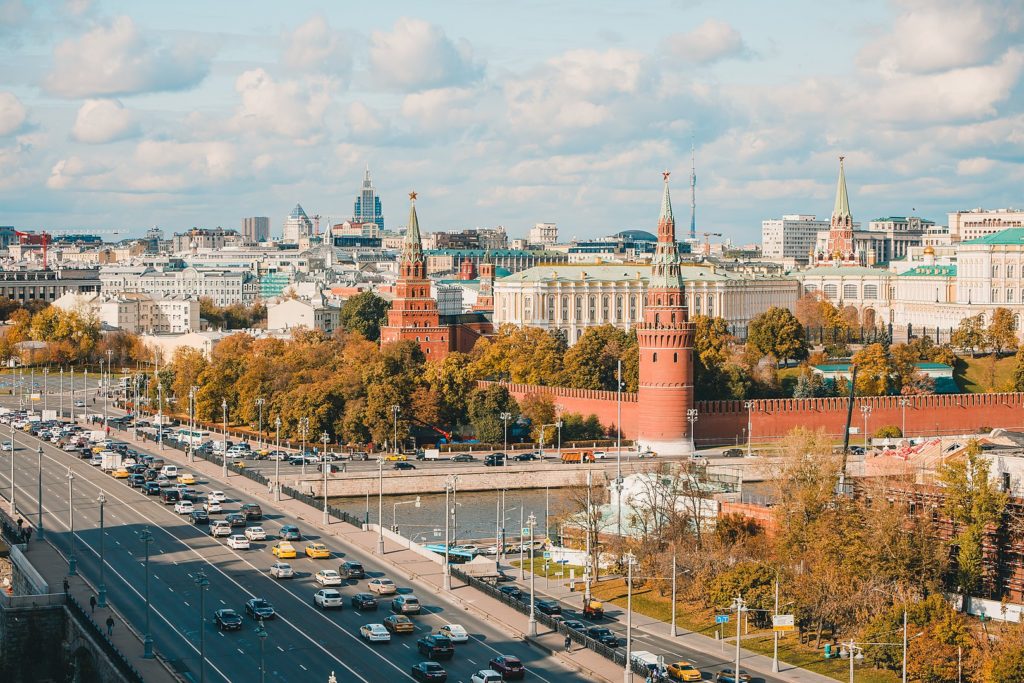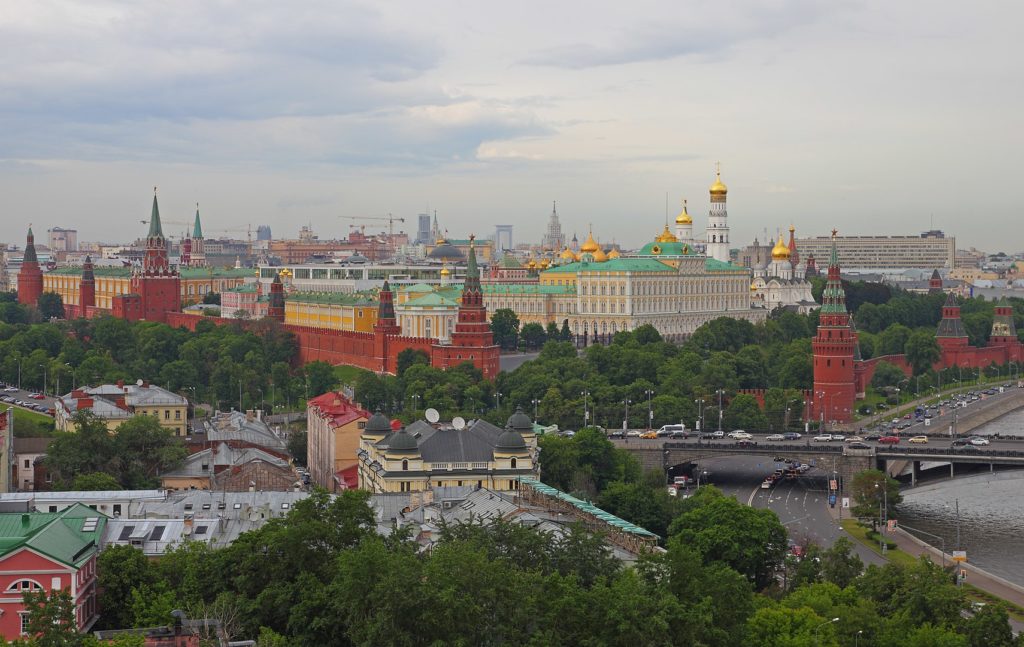
By Semyon Borisov – Wikimedia
Top 10 Facts about the Moscow Kremlin
Moscow is the capital city of Russia. It is also the biggest city in Europe. This city is the hotspot for cultural, political and economic activities in Russia and eastern Europe.
It is a city renowned for the Red Square, the Kremlin and St. Basil’s cathedral.
Kremlin in Russia is one of the world’s most remarkable buildings. It is found in the Red Square and is imposingly the most spectacular building in Russia.
This building is the most visited in Moscow and has many other attractions nearby.
The Kremlin started off as a fortress overlooking the Moskva River. It is between Saint Basil’s Cathedral and Red Square to the east and the Alexander Garden to the West.
Made up of four cathedrals and five palaces, the Moscow Kremlin is famous among all Kremlins in Russia. Every city in Russia has a Kremlin.
There’s every reason why a visit to the Moscow Kremlin needs to be on your bucket list. Here are the top 10 facts about it.
1. The Kremlin is the largest fortification in Europe

By A.Savin – Wikimedia
Not only is this the largest old-fashioned fortress in Russia, but it is also the biggest fortress still in use in Europe.
It was first made of wood then stone and finally bricks were used. the Kremlin used to be a city with fortifications, towers and bulwarks.
Every city in Russia has its own Kremlin. The Moscow Kremlin is irregular in shape and is surrounded by huge walls and towers.
The towers were used to protect the bridge to Kremlin. Only one survived, it was built in 1516.
On the East side of the Kremlin triangle, are the river Moskva and the underground Neglinnaya River.
This section of the Kremlin was the most vulnerable to attacks. The wall on this side of the Kremlin is the highest. Italian architects were contracted to build the walls.
2. The Kremlin of Moscow is the most popular one
The word Kremlin means fortress within a city in Russian. Every city in Russia had its own fortress.
While they are several, the Moscow Kremlin is the most popular one. It is the symbol of the Russian state.
3. The word Kremlin has been used since the 14th Century

An undated photo of the Kremlin. Photo by Alexey Ivanovich Savelyev – Wikimedia
The construction of the Moscow Kremlin was ordered by Prince Yury Dolgoruky.
It was made of wood in 1156. The term Kremlin was first recorded in the 14th century.
Prince Ivan III renovated the Kremlin with the help of skilled architects from Renaissance Italy.
Petrus Solarius helped design the Kremlin’s towers and walls, while Marcus Rufus designed the new palace for the prince.
Prince Ivan oversaw the construction of three cathedrals that are still standing in the Kremlin.
4. A moat separates the Kremlin and the town

By Suicasmo – Wikimedia
After the new kremlin walls and churches were completed, the monarch ordered that no structures were to be built near the Kremlin.
There was a wall between the Kremlin and a merchant town. A 30-metre-wide moat was dug between the Kremlin and the town.
This also allowed the monarch to see approaching enemies. One architect advised Ivan the Great to have a clearing outside the walls of the Kremlin.
5. The Kremlin was abandoned for some time
While the Kremlin was occasionally used to host coronation ceremonies, it was abandoned in 1773. This was after Catherine the Great commissioned Vasili Bazhenov to build her residence.
This architect’s neoclassical design involved the demolition of several churches and palaces.
It was later abandoned after the empress ran out of funds. Once funds were available, another architect supervised the construction of the stalled structures.
6. Napoleon Bonaparte ordered the destruction of the Kremlin

By Adolphe Roehn – Wikimedia
Napoleon led his French troop to the Kremlin in 1812. He then ordered his troop to destroy the Kremlin.
The wall, arsenal and wall towers of the Kremlin were blown up. He also damaged the churches using fire.
Explosions were constant for three days, luckily, it rained and the churches were not completely damaged.
7. Different Russian Leaders chose different rooms during their term
The Soviet government occupied the Kremlin in Moscow in 1918. Vladimir Lenin was the first communist leader to use the Kremlin as his residence.
Joseph Stalin also had his private rooms in the Kremlin. He removed all the relics from the Tsars of Russia from the headquarters.
Stalin replaced the golden eagles on the towers with shining Kremlin stars.
Vladimir Putin ordered the construction of a helipad in order to stop disrupting traffic caused by his motorcade.
The location of the helipad has in no way interfered with the architecture of the Kremlin.
8. Italian architects built the Kremlin tower and walls

By Suicasmo – Wikimedia
The current Kremlin walls and towers were built by Italian architects between 1485 to 1495.
They built 18 Kremlin towers which were later increased to 20 in the 17th century. Most of the towers were initially crowned with wooden tents.
9. There are three cathedrals at the Kremlin of Moscow
Cathedral Square is at the centre of the Kremlin. The Cathedral of the Dormition was completed in 1479 and was to be the main church of Moscow. This is where the Tsars were crowned.
Several city residents and patriarchs were buried at the cathedrals.
The gilded, three-domed Cathedral of the Annunciation was completed in 1489. Renovations were done and 6 more domes were added.
On the south-east of the square is the Cathedral of the Archangel Michael completed in 1508. It is the largest of the three churches.
All the Muscovite monarchs were buried in this cathedral.
10. The oldest structure at the Kremlin of Moscow is from 1491
The oldest nonreligious structure at the Kremlin is Ivan III’s Palace of Facets built-in 1491.
Terem Palace is the second oldest building at the Kremlin, it was home to the first royal family. This palace was commissioned by Ivan III.
The Terem Palace and the Palace of Facets are linked by the Grand Kremlin Palace.
Planning a trip to Paris ? Get ready !
These are Amazon’s best-selling travel products that you may need for coming to Paris.
Bookstore
- The best travel book : Rick Steves – Paris 2023 – Learn more here
- Fodor’s Paris 2024 – Learn more here
Travel Gear
- Venture Pal Lightweight Backpack – Learn more here
- Samsonite Winfield 2 28″ Luggage – Learn more here
- Swig Savvy’s Stainless Steel Insulated Water Bottle – Learn more here
Check Amazon’s best-seller list for the most popular travel accessories. We sometimes read this list just to find out what new travel products people are buying.










